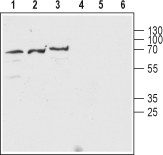Overview
- Peptide (C)EDFDNMKKVRLP, corresponding to amino acid residues 96-107 of rat nAChRβ2 (Accession P12390). Extracellular, N-terminus.
- Rat and mouse brain lysate and SH-SY5Y human neuroblastoma cell lysate (1:200).
 Western blot analysis of SH-SY5Y human neuroblastoma cell lysate (lanes 1 and 4) and rat (lanes 2 and 5) and mouse (lanes 3 and 6) brain lysate:1-3. Anti-Nicotinic Acetylcholine Receptor β2 (CHRNB2) (extracellular) Antibody (#ANC-012), (1:200).
Western blot analysis of SH-SY5Y human neuroblastoma cell lysate (lanes 1 and 4) and rat (lanes 2 and 5) and mouse (lanes 3 and 6) brain lysate:1-3. Anti-Nicotinic Acetylcholine Receptor β2 (CHRNB2) (extracellular) Antibody (#ANC-012), (1:200).
4-6. Anti-Nicotinic Acetylcholine Receptor β2 (CHRNB2) (extracellular) Antibody, preincubated with Nicotinic Acetylcholine Receptor β2/CHRNB2 (extracellular) Blocking Peptide (#BLP-NC012).
- Mouse pancreas sections (1:200) (Ganic, E. et al. (2016) Cell Rep. 14, 1991.).
- Live intact PC12 rat pheochromocytoma cell line (1:100-1:200).
Acetylcholine, released by cholinergic neurons, activates two groups of acetylcholine receptors (AChRs); muscarinic AChRs (mAChRs), which belong to the G-protein coupled receptor (GPCR) superfamily, and nicotinic AChRs (nAChRs), which belong to the ligand-gated ion channel superfamily. nAChRs also respond to nicotine, hence their name1.
To date, 17 different but related subunits of nAChRs have been identified and cloned. They consist of α subunits (α1-10), which is responsible for the binding of ligands. In fact, this subunit includes a Cys-loop in the first extracellular domain that is required for agonist binding2. The other subunits responsible for making up the active receptor are the β (β1-4), γ, δ and ε subunits3. Structurally, all subunits have the following: a conserved large extracellular N-terminal domain, three conserved transmembrane domains, a variable cytoplasmic loop and a fourth transmembrane domain with a short extracellular C-terminal domain. An active nAChR is generally a heteropentamer of these various subunits organized around a central pore1.
While most β subunits are neuronal, the β1 subunit forms functional receptors along with other subunits in the muscle3. The diversity of these receptors and their functional organization gives rise to unique properties and functions. The α4β2 receptor composition makes up a high affinity nicotinic receptor. In fact, its upregulation (mainly expressed by the increase of functional receptors at the membrane and not expression per se) is responsible for the increased appearance of binding sites following nicotine administration1,3.
Animal studies have shown that nAChR-related mechanisms are involved in attention function4. Indeed α4β2 nAChR seems to also be involved in attention-deficit hyperactivity disorder (ADHD), a disease distinguished by a lack of attention, distractibility and hyperactivity3. The α4β2 and α7 nAChRs appear to be critical in rats for attention and working memory. Also, a α4β2 specific agonist was shown to reduce impulsivity, hyperactivity and attention deficits in adults with ADHD5. This same receptor subtype may also be involved in Parkinson’s disease (PD) as smoking and α4β2 nAChR agonists show beneficial effects in PD6,7.
